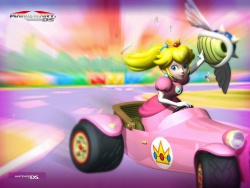Difference between revisions of "Women in Gaming"
(→Acceptance of Female Gamers) |
m (Protected "Women in Gaming" ([Edit=Allow only administrators] (indefinite) [Move=Allow only administrators] (indefinite))) |
||
| (116 intermediate revisions by 34 users not shown) | |||
| Line 1: | Line 1: | ||
| − | {{Nav-Bar|Topics#W}} | + | {{Nav-Bar|Topics#W}}<br> |
| − | [[File:Evil.jpeg|200px|thumb|right|Saving the world one picture at a time. Beyond Good and Evil a game with one of the few complex and positively portrayed female lead character.]] | + | [[File:Evil.jpeg|200px|thumb|right|Saving the world one picture at a time. Beyond Good and Evil is a game with one of the few complex and positively portrayed female lead character.]] |
| − | + | [[File:CorrinneYuReikyu.jpg|200px|thumb|right|Corrine Yu Reikyu, Lead Halo Engine Programmer]] | |
| − | [[Image:Lady-large.jpeg|200px|thumb|right|Members of the PMS Clan | + | [[Image:Lady-large.jpeg|200px|thumb|right|Members of the PMS Clan. From left: Kendra Taylor, Shannon Ridge (kneeling), Marcella Fernandez, Amber Dalton, Felicia Williams, Alexis Hebert (kneeling), and Caitlin Buckshaw. Image from USA Today.]] |
| − | + | '''Women in Gaming''' is a concept emphasizing women's role, or lack thereof, as video game players or characters. While men have continuously been both the driving force and target audience behind the creation of video games, the [[Wikipedia:Girl gamer|female gamer]] population has grown. [[Wikipedia:Video game|Video games]] are increasingly encompassing characteristics that of female interest, and the gaming environment is slowly becoming a more gender-neutral playing field.<ref name="mitpress">The MIT Press: "Play Between Worlds" [http://mitpress.mit.edu/catalog/item/default.asp?ttype=2&tid=10770 Taylor, T.L. (2003). “Multiple Pleasures: Women and Online Gaming,” Convergence, v.9, n.1.]</ref> Game designers have become increasingly aware of gamers' difficulties in accepting gender representations in game play. Though, gamers recognize that men and women play a varied selection of games, many of which cannot be categorized by sex, however the portrayal of gender still exists in the more gender-neutral games.<ref> MacCallum-Stewart, E. (2009). 'The street smarts of a cartoon princess'. New roles for women in games. Digital Creativity, 20(4), pp. 225-37. </ref> The portrayal of women in games becomes ethically charged as gaming's prevalence increases and as virtual images begin to directly mirror the ''living world''. | |
| − | '''Women in Gaming''' is a concept emphasizing women's role | + | |
| − | + | ||
| − | + | ||
| − | + | ||
| + | ==History== | ||
| + | There are many arguments developed by researchers, [[Wikipedia:Software developer|software developers]], and females alike, that seek to explain why women have been absent from the gaming scene until recent years. Theories include: | ||
*The difference in social characteristics between females and males | *The difference in social characteristics between females and males | ||
*The appeal of game content to women | *The appeal of game content to women | ||
*How women are portrayed in gaming | *How women are portrayed in gaming | ||
| − | === | + | ===Social Constriction=== |
| − | One explanation for | + | One explanation for women's absence in the [[Wikipedia:History of video games|history of gaming]] is that because gaming is considered to be asocial, females (which are typically more sociable than men) are less likely to find the appeal in gaming. Historically, many women place a greater concern for domestic and/or social activities, rather than leisure activities like [[Wikipedia:Gameplay|gameplay]]. Therefore, women have not exerted as much time or effort towards becoming active members of the gaming world, preferring social interaction in the physical world.<ref name="mit"> MITCogNet Website: "From Barbie to Mortal Combat" [http://cognet.mit.edu.proxy.lib.umich.edu/library/books/view?isbn=0262032589 Cassell, J and Jenkins, H. (eds) (1998). "From Barbie to Mortal Kombat: Gender and Computer Games". Cambridge, MA: The MIT Press.]</ref> |
| − | + | Additionally, due to certain [[Wikipedia:Social construction|social constructs]], the male population is more likely to be introduced to games at an early age. According to the studies of Bryce & Rutter, males have traditionally had more access to and control over leisure spaces such as [[Wikipedia:Video arcade|video arcades]] and sports venues.<ref name="digi"/> It has also been argued that males are more likely to learn through action.<ref name="mit"/> | |
| − | males have traditionally had more access and control over leisure spaces such as [[Wikipedia:Video arcade|video arcades]] and sports venues | + | |
| − | + | Women today still live in a patriarchal society. As a result, men are stereotypically socially constructed to be "powerful," "aggressive," and "strong," while women are "passive" and "quiet".<ref>Oneonta Website: "The Social Construction of Website" http://www.oneonta.edu/faculty/farberas/arth/arth200/gender.html</ref> Because of these stereotypes, women tend to play fewer video games, as games have traditionally been marketed as fit for the masculine, violent and aggressive.<ref name = "science"/> Men are also usually portrayed as more powerful and aggressive characters in video games, while women are generally represented as less important characters. Because of this, many games have not been appealing to women. The [[Wikipedia:Portrayal of women in video game| gender stereotyping]] found in many video games today consists of the absence of female characters, female characters that are less important than male characters, aggression towards female characters, and eroticism of female characters. All of these tendencies have produced an environment where female representation falls victim to male supremacy. The representation of women in these games are likely to deter women from participating in these games, to begin with, which creates a cycle in which women are not represented in the gaming world.<ref name="eric">"Education Resources Information Center Website: "Girl Gamers: The Controversy of Girl Games and the Relevance of Female-Oriented Game Design for Instructional Design" http://www.eric.ed.gov:80/ERICWebPortal/custom/portlets/recordDetails/detailmini.jsp?_nfpb=true&_&ERICExtSearch_SearchValue_0=EJ739503&ERICExtSearch_SearchType_0=no&accno=EJ739503 Dickey, M.D. (2006) 37(5). 785-793.</ref><ref name = "sagepub">SAGE Journals Website: Violent Video Games and Hostile Expectations: A Test of the General Aggression Model. Royse, Pam. (2007). "Women and games: technologies of the gendered self". Los Angeles, London, New Delhi, and Singapore. SAGE Productions.http://nms.sagepub.com/cgi/content/abstract/9/4/555 </ref><ref name = "hein">Hein Online: "Mediated Images of Violence and the First Amendment: From Video Games to the Evening News" http://heinonline.org/HOL/Page?handle=hein.journals/maine57&div=10&g_sent=1&collection=journals/</ref><ref name = "science">SciVerse Website: "Video Game Violence: A review of the empirical literature" http://www.sciencedirect.com/science/article/pii/S1359178997000013/</ref>. | |
| − | + | ||
| − | === Game Content === | + | ===Game Content=== |
| − | + | Historically, the content of games has not always been appealing to women, since games were being marketed predominantly for males. However, game content is changing and more games either encourage women to play or are considered gender neutral. The 1980s brought about drastic changes to the gaming environment, as it introduced several groundbreaking genres, such as [[Wikipedia:Adventure game|adventure]], [[Wikipedia:Platform game|platform]], [[Wikipedia:Racing game|racing]] and [[Wikipedia:Role-playing game (video games)|role-playing games]]. The varying styles of [[Wikipedia:Gameplay|gameplay]] encouraged a more diverse [[Wikipedia:Gamer|gamer]] population, catering to many different interests and skills, but many games today are still of a violent nature. | |
===Stereotypes=== | ===Stereotypes=== | ||
| − | + | [[File:Girl_gamer.jpg|250px|thumb|right|An example of an unrealistic body type portrayed in a video game]] | |
| − | | | + | ====Women as Victims or Objects==== |
| − | * | + | *Women are depicted both as the quest object to be saved and as the reward of the self same quest |
| − | ** | + | *Relegated to the status of children |
| − | ** | + | *Difficult for women to identify with both active player and passive object |
| − | + | ====Gender Stereotyping==== | |
| + | *Hostility ("orientalized" view of females/women)<ref name = "sagepub"/><ref name = "hein"/> | ||
| + | *Discrimination (i.e., gender racism or sexism)<ref name = "refsciencedirect"/><ref name = "eric">[http://eric.ed.gov/ERICWebPortal/search/detailmini.jsp?_nfpb=true&_&ERICExtSearch_SearchValue_0=ED413986&ERICExtSearch_SearchType_0=no&accno=ED413986/ Seeing the World through "Mortal Kombat" Colored Glasses: Violent Video Games and Hostile Attribution Bias]</ref><ref name = "sagepub"/> | ||
| + | ====Other==== | ||
| + | *Cultural conservatism in terms of 'Tradition' [i.e. Tradition of Video Gaming geared, created by and for Males], in a historiographic/nostolgia-sense | ||
| + | *Copycat of video games and in terms of acting out violence toward/against Women<ref>Wiley Online Library: "Mortal Kombat" http://onlinelibrary.wiley.com/doi/10.1111/j.1559-1816.1996.tb02740.x/abstract</ref><ref name = "refsciencedirect"/><ref name = "eric"/><ref name = "sagepub"/><ref name = "hein"/> | ||
| + | *Economic/Money-based "considerations angle" toward all of this | ||
| + | *Theoretical view (i.e. wanting to showcase/market toward females and end discriminatory practices/stereotypes) but in actuality not enough difference in the "bottom-line" (an argumentive-dilemna) | ||
| + | *Lack of "true" proof that girls/females are truly engaged with or into video games (rationale/"excuse" of video-game makers/developers) | ||
| − | + | ==Emergence of Female Gaming Culture== | |
| − | + | ===First Games Targeting Female Audiences=== | |
| − | + | In 1997, [[Wikipedia:Mattel|Mattel]] released Barbie Fashion Designer, one of the first games that targeted a female audience. Barbie Fashion Designer sold over 600,000 copies and is considered to be the first entertainment software to capture a mass female market. The tremendous success of this game started a movement towards the development and production of games designed specifically for girls. Applications such as Barbie Fashion Designer, [[Wikipedia:American Girl|American Girl]] interactive software, and the [[Wikipedia:Nancy Drew|Nancy Drew]] adventure games did remarkably well and their success is attributed to the high appeal of real life, everyday characters to the female population.<ref name="mit"/> | |
| − | + | [[Image:Nancy Drew.jpg|200px|right|thumb|Nancy Drew computer game]] | |
| − | + | ||
| − | + | ||
| − | + | === Women in Gaming Today === | |
| − | + | While all studies confirm that men still dominate the virtual gaming world<ref name="sagepub">SAGE Journals Website: Violent Video Games and Hostile Expectations: A Test of the General Aggression Model http://nms.sagepub.com/cgi/content/abstract/9/4/555 Royse, Pam. (2007). "Women and games: technologies of the gendered self". Los Angeles, London, New Delhi, and Singapore. SAGE Productions.</ref> women are becoming a more active part of the community and have even dispersed into their own subgroups. According to the [[Wikipedia:Entertainment Software Association|Entertainment Software Association]], roughly 40% of all video game players are female.<ref>The Entertainment Software Association Website http://www.theesa.com/</ref> In addition, the female population represents over 43% of online players and are the fastest growing demographic in the gaming industry. Such distinctions among the female population have been made based on different reasons for gaming, varying interests and preferable gaming genres.<ref name="sagepub"/> These subclasses of female gamers can be defined as [[Wikipedia:Power gamer|Power-gamers]], Moderate-gamers and Non-gamers.<ref name="sagepub"/> | |
| − | + | ||
| − | + | ||
| − | + | ||
| − | + | === Women in Professional Gaming === | |
| − | + | [[Image:fd.jpg|200px|left|thumb|Members of the professional female gamer team, the Frag Dolls.]] | |
| − | + | The PMS (Pandora's Mighty Soldiers) clan was formed in 2002 by twin sisters Amber Dalton and Amy Brady. The PMS clan has an international roster of over 500 ladies and is one of several professional female gaming organizations. | |
| − | + | ||
| − | + | ||
| − | + | ||
| − | + | ||
| − | + | ||
| − | + | In August of 2004, a team of professional female gamers around the United States formed a group named, The Frag Dolls. They had been recruited by [[Wikipedia:Ubisoft|Ubisoft]] to promote their games and represent the presence of women in the game industry. They have participated in gaming events and tournaments. Their popularity grew after they won the Rainbow Six 3: Black Arrow tournament in 2004. The genres of games that they play range from shooters ([[Wikipedia:Halo 3|Halo 3]]) to music ([[Wikipedia:Guitar Hero 2|Guitar Hero 2]]). In 2007, they ranked 11th place overall in the Major League Gaming season in [[Wikipedia:Rainbow Six Vegas|Rainbow Six Vegas]] making them the first all-female team to make Semi-Professional status in Major League Gaming history.<ref>Frag Dolls Website: About Section http://www.fragdolls.com/index.php/gamer-girls</ref>{{cls}} | |
| − | + | ||
| − | + | ===Women in Game Engineering=== | |
| − | + | As of December 2011, a survey conducted that only around 12% of game engineers are women.<ref> Stuart, Keith. [https://www.theguardian.com/technology/2011/dec/08/women-videogames-designing-writing "Game changers: the women who make video games"] (8 December 2011. Retrieved on 20 April 2017.)</ref> The number of women who work as game engineers is predicted to increase as games on social media sites and mobile devices become more and more popular. The Nintendo Wii console and sites like Facebook are becoming popular with the younger generations which is opening up many different positions for women in game engineering. They are able to offer a different perspective in the gaming world. | |
| − | == | + | ==Acceptance of Female Gamers== |
| − | + | [[File:Jessicapapers.jpg|240px|thumb|right|The picture of legal documents that Jessica tweeted informing anti-fans that she would pursue legal action]] | |
| + | [[File:web.jpg|240px|float|frame|left|Webb: two steps forward and two steps back]] | ||
| + | ===x-play and Morgan Webb=== | ||
| + | The long-time host Morgan Webb of the G4's show on computer games, [[Wikipedia:X-play|x-play]], was initially viewed not as a gamer but as a television personality. Her reception as a host only implied that she had been added to the show for her gender and looks, not her gaming ability. The view that Webb was added purely for her gender was long lasting and a popular discussion topic relating to her and the show was whether or not she possessed gaming skills. Eventually, the constant questioning of Webb's abilities in viewer submitted mail led the subject to be treated like a joke. It is unclear what caused the shift in perception, but Webb now garners ''bona fide'' gamer status. Though following a non-nude yet eroticized picture spread in a magazine, she is also seen as a sex symbol. | ||
| − | + | ===Female Gamers and Multiplayer=== | |
| + | Women face a challenge of not being accepted as "real" gamers by portions of the male gaming community.<ref> Meléndez, Elisa. [http://www.slate.com/articles/double_x/doublex/2012/08/sexual_harassment_in_the_gaming_world_a_real_life_problem_for_female_gamers_.single.html "What It’s Like For a Girl Gamer"] (13 August 2012. Retrieved on 20 April 2017.)</ref> One reason for this is a belief that females only expressed interest in videogames to gain the attention of males. Part of the explanation used to justify this perspective is the claim there are no females that play games. However, an alternative explanation is that women will hide information that reveals themselves as female to male gamers as a way to avoid harassment.<ref> [http://www.urbandictionary.com/define.php?term=girl+gamer&defid=6107607 "Urban Dictionary: girl gamer"]</ref> | ||
| + | In physical environments, harassment can take the form of crude comments and overt sexual harassment.<ref>[http://www.npr.org/2012/08/08/158433079/virtual-harassment-gets-real-for-female-gamers "Online Harassment Gets Real For Female Gamers"] (8 August 2012. Retrieved on 20 April 2017.)</ref> | ||
| + | Online harassment is more intense and consists of voice chat, private messages, and occasional pictures of genitalia.<ref> Fletcher, James. [http://www.bbc.com/news/magazine-18280000 "Sexual harassment in the world of video gaming"] (4 June 2012. Retrieved on 20 April 2017.)</ref> These messages often progress in tone from soliciting sexual contact to insulting the recipient upon refusing the sender's advances. The [[Tumblr]] blogs [http://fatuglyorslutty.com/ Fat, Ugly, or Slutty] and [http://www.notinthekitchenanymore.com/ Not In The Kitchen Anymore] were started to document this phenomenon. Although [[wikipedia:Microsoft|Microsoft ]] plans on implementing a zero-tolerance policy towards this harassment on Xbox Live<ref name="xboxlivesexism">Parker, Lauren. | ||
| + | [http://www.gamespot.com/news/halo-4-devs-speak-out-against-sexism-6399205 Halo 4 devs speak out against sexism]. ''Gamespot'', 31 Oct. 2012. Web. 23 Apr. 2017.</ref>, this does not affect issue on other platforms. | ||
| + | Another reason why the male gaming community does not consider female gamers is because they often use gaming as an excuse to make a monetary profit instead of playing for the sake of entertainment. For example, female gamers make money out of skinning/modding by creating skins for female gamers only. <ref>Kennedy, Helen. Female Quake Players and the Politics of Identity. Chapter 19.</ref> Harassment towards female players is a prevalent issue and has many female gamers have created clans as support structures that communicate an oppositional female identity which often include top gear female gamers who dominate male teams. Many women of color are also harassed and they have created women-of-color clans who use aggressive griefing tactics to fight back racism/sexist comments. <ref>Gray, Kishonna. [http://adanewmedia.org/2013/06/issue2-gray/ Collective Organizing, Individual Resistance, or Asshole Griefers? An Ethnographic Analysis of Women of Color In Xbox Live], Feminist Game Studies. ''Ada: A Journal of Gender, New Media, and Technology'', 23 Apr. 2017.</ref> | ||
| − | === | + | ===Professional Female Gamers=== |
| + | On June 14, 2011, the professional [[Wikipedia: StarCraft II: Wings of Liberty|StarCraft II]] team SlayerS Clan added Eve, the first female professional gamer, to their roster.<ref>Team Liquid Website: StarCraft 2 http://www.teamliquid.net/forum/viewmessage.php?topic_id=243800</ref> Many SlayerS and StarCraft II fans were outraged by the new addition to the team roster, as they felt that Eve was under qualified compared to the other members of SlayerS and that she was simply recruited due to her gender. The drama surrounding the situation grew very quickly, and Eve began receiving numerous inappropriate and abusive tweets and letters from detractors. Eventually, the SlayerS team manager, Jessica, decided to resort to legal action against many of those who harassed Eve.{{cls}} | ||
| − | + | In 2016, Remilia, League of Legends' professional scene's only female player<ref>The League of Legends Championship Series Has Its First Woman Player http://kotaku.com/the-league-of-legends-championship-series-has-its-first-1724136651</ref>, left her team, allegedly due to harassment from the gaming community.<ref>Remilia leaves Renegades https://www.reddit.com/r/leagueoflegends/comments/43m33a/remilia_leave_renegades/</ref> In addition to being a female League of Legends professional player, she was also transgender, leading to her experiencing twofold harassment from the gaming community. | |
| − | + | On April 20th, 2017, it was announced that the all-girls college Stephens College would be the first university with an all-female eSports program.<ref>Rising Stars: All-women's Stephens College breaks ground with varsity eSports program http://www.espn.com/esports/story/_/id/19195390/all-women-school-stephens-college-adds-scholarship-esports-program</ref> The first team that will be a part of this will be an Overwatch team to compete in the Overwatch [[Tespa]] tournament ([[Blizzard Entertainment]]'s collegiate tournament program) in Fall 2017. | |
| − | + | ||
| − | + | ||
| − | + | Websites like gamergirl.com provides a way for women to colonize and exchange ideas about games, and their role in the gaming world.<ref>http://www.girlgamer.com/zine/article/1685/</ref> | |
| − | == | + | ==Current Preferences of Women Gamers== |
| + | Various studies of female preferences in game design, conducted by various research groups such as the [[Wikipedia:Women,_girls_and_information_technology|American Association of University Women Educational Foundation Commission on Technology, Gender and Teacher Education]], reveal that game preferences of women consist of, but are not limited to: | ||
| + | *Collaboration | ||
| + | *Communication | ||
| + | *Positive action | ||
| + | *Challenge | ||
| + | *Use of strategies and skills | ||
| + | *Ability to design and create | ||
| + | *Adventure | ||
| − | + | While there are many similarities among female gaming preferences, the most prominent are communication, collaboration, and positive representation. Games, especially those online, are beginning to adopt these characteristics in an attempt to draw in greater female participation. For example, [[Wikipedia:Everquest|EverQuest (EQ)]] provides appropriate levels of challenge, collaboration, communication, self-selection of roles, and exploration; all of which appeal to a female audience.<ref name="mitpress"/> Such elements as narratives, ability to self-select roles, interactive challenges, collaboration and community are all drawing in a higher percentage of female players.<ref name="mitpress"/> | |
| − | + | ||
| − | + | In addition to focus groups and observational studies, much research has gone into evaluating television viewing and reading preferences among females.<ref name="mit"/> Common themes that are of interest to females are those involving romance, family relationships, and realistic settings. With emphasis on the drama of human relationships, video games have the potential to be even more successful by allowing women to apply their social and emotional revelations from the game to their actual lives.<ref name="mit"/><ref>ACM Digital Library: "Beyond Barbie and Mortal Kombat: New Perspectives on Gender and Gaming" [http://dl.acm.org/citation.cfm?id=1468058/ ]</ref> | |
| − | + | ||
| − | + | ||
| − | + | ||
| − | + | ||
| − | + | ||
| − | + | ||
| − | + | ||
| − | + | ||
| − | + | ||
| − | + | ||
| − | + | ||
| − | + | ||
| − | + | ||
| − | + | ||
| − | + | ||
| − | + | ||
==Video Games with Female Main Characters== | ==Video Games with Female Main Characters== | ||
| − | Examples of female characters in video games: | + | Examples of prominent female characters in video games: |
{|border="1" cellpadding="5" cellspacing="0" align="center" | {|border="1" cellpadding="5" cellspacing="0" align="center" | ||
|- | |- | ||
| Line 130: | Line 121: | ||
|Princess Peach | |Princess Peach | ||
|Mario Series | |Mario Series | ||
| + | |- | ||
| + | |[[File:Chell_Icon.jpg|100px]] | ||
| + | |Chell | ||
| + | |Portal Series | ||
| + | |[[File:PrincessZelda.jpg|100px]] | ||
| + | |Princess Zelda | ||
| + | |Legend of Zelda Series | ||
|- | |- | ||
|[[File:ellenf.jpg|100px]] | |[[File:ellenf.jpg|100px]] | ||
| Line 145: | Line 143: | ||
|Metroid Series | |Metroid Series | ||
|- | |- | ||
| − | |[[File: | + | |[[File:Jade_2011.jpg|100px]] |
| − | | | + | |Jade |
| − | | | + | |Mortal Kombat (Principal) Games 2011 |
|[[File:sarahs.jpg|100px]] | |[[File:sarahs.jpg|100px]] | ||
|Sarah Kerrigan | |Sarah Kerrigan | ||
|Starcraft | |Starcraft | ||
| + | |- | ||
| + | |[[File:laratr.jpg|100px]] | ||
| + | |Lara Croft | ||
| + | |Tomb Raider Series | ||
| + | |[[File:Sonyablade.png|100px]] | ||
| + | |Sonya | ||
| + | |Mortal Kombat (Principal) Games | ||
| + | |- | ||
| + | |[[File:Red.jpg|100px]] | ||
| + | |Red | ||
| + | |Transistor | ||
| + | |[[File:Elizabeth.jpg|100px]] | ||
| + | |Elizabeth | ||
| + | |Bioshock Infinite | ||
|- | |- | ||
|[[File:lightningff.jpg|100px]] | |[[File:lightningff.jpg|100px]] | ||
| Line 158: | Line 170: | ||
|Yuna | |Yuna | ||
|Final Fantasy X-2 | |Final Fantasy X-2 | ||
| − | |||
| − | |||
| − | |||
| − | |||
| − | |||
| − | |||
| − | |||
|} | |} | ||
| − | == | + | ==Characteristics of Female Characters in Video Games== |
| − | + | [[File:Princess-Peach-mario-kart-1993912-1024-768.jpg|250px|thumb|left|Princess Peach from Nintendo's Super Mario Bros. Series]] | |
| − | + | ===Absence=== | |
| − | + | Many video games have a lack of female characters or players. Since the creation of video games, female characters have primarily been included in story-lines as objects, and often portrayed as victims. Some examples include: [[Wikipedia:Zelda_ocarina_of_time|The Legend of Zelda: Occarina of Time]] where Ganondorf, the antagonist, kidnaps [[Wikipedia: Princess Zelda|Princess Zelda]] as part of the story line, and gamers control Link to save her; [[Wikipedia:Super_Mario_(series)|Super Mario(Series)]] where Bowser, the antagonist, kidnaps [[Wikipedia:Princess_Peach|Princess Peach]], and gamers control Mario to rescue her; and [[Wikipedia:Teenage_Mutant_Ninja_Turtles_(arcade_game)|Teenage Mutant Ninja Turtles]] where Shredder, the antagonist, kidnaps [[Wikipedia:April_O%27Neil|April O'Neil]], and four ninja turtles attempt to save her as a mission.<ref name="digi">Bryce, J. & Rutter, J. (2002). “Killing Like a Girl: Gendered Gaming and Girl Gamers’ Visibility” in CGDC Conference Proceedings, F. Mayra (ed.). Tampere: Tampere University Press. http://digiplay.info/files/cgdc.pdf </ref> | |
| − | + | ||
| − | + | ||
| − | + | ||
| − | + | ||
| − | + | ||
| − | + | ||
| − | + | ===Abilities=== | |
| + | When female characters were first introduced into games populated by male characters, many of them were not given the same or equal abilities. Abilities include mostly skills like speed, strength, or flexibility. For example, in [[Wikipedia: Super_Smash_Bros._(series)|Super Smash Brothers]], female characters, such as Princess Peach and Samus, are often slower or less powerful than their male counterparts. However, this stigma changed over time. In the 1993 game Super Mario Bros. 2, Princess Peach had the unique ability of flotation, allowing her to make jumps that the other characters could not.<ref>Super Mario Bros. 2, [[Wikipedia:Super_Mario_Bros._2|Wikipedia]]</ref>. | ||
| − | + | ===Aggression=== | |
| + | Many video games also depict aggression towards female characters. Some games, such as [[Wikipedia:Quake|Quake]] and [[Wikipedia:Doom (game)|Doom]], have been accused of crossing a line with the inclusion of dialogue and actions that enable [[Wikipedia:Sexual harassment|sexual harassment]] towards women.<ref name="eric"/><ref name = "refsciencedirect">SciVerse Website: "Effects of Violent Video Games on Aggressive Behavior: Potential Sex Differences" http://www.sciencedirect.com/science/article/pii/S0022103101915021/ </ref><ref name = "hein"/><ref name = "science"/> In other games such as [[Grand Theft Auto IV]] there are numerous women characters who are prostitutes and can be killed by the males.<ref> http://www.salon.com/2008/05/03/gta_2/</ref> | ||
| + | [[Image:tr-anniversary.jpg|thumb|right|200px|Lara Croft: Tomb Raider]] | ||
| − | == | + | ===Background Decoration=== |
| + | When female characters are present in the game, their role is usually not as significant as males. Females are generally background characters or characters that are not relevant or important to the story line. Their actions do not have as a significant impact compared to others (usually males). Many female characters are non-playable that are only see as part of the environment or landscape of the game. Because many female characters are non-playable characters, they are not given an identity or voice to express themselves. Females with no identity are only seen as decoration or objects for males to enjoy.<ref>Women as Background Decoration http://everydayfeminism.com/2014/09/women-as-background-decoration/</ref> | ||
| + | ===Eroticisation=== | ||
| + | A common criticism of video games is the unrealistic representation and objectification of female characters. Many critics note specific stereotypes such as women as objects of a predominantly male desire, a double-Standard (sexual objectivism is applied to women only), and female characters having unrealistic body types. For example, Lara Croft from the game [[Wikipedia:Tomb_Raider|Lara Croft: Tomb Raider]], has unrealistic, arguably impossible, body proportions.<ref name="eric"/> | ||
| + | |||
| + | Certain video games developers have gone to great lengths to sexually objectify female characters. Developers from the fighting game series [[Wikipedia:Dead_or_Alive_(series)|Dead or Alive]] focused heavily on creating accurate breast physics and increasing the sexual appeal of female characters in the fifth iteration of the game. In addition, the same creators produced the [[Wikipedia:Dead_or_Alive_Xtreme_Beach_Volleyball|Dead or Alive Xtreme Beach Volleyball]] game. | ||
| + | |||
| + | ===Breast Physics=== | ||
| + | |||
| + | The movement of breasts, particularly in fighting games, is often discussed as an example of sexualization of women in video games. A myriad of factors determines the mobility of breasts in games, including sex appeal, processing power, and return on investment. | ||
| + | |||
| + | Most games that use 3D models operate using textures (called skins) which move according to a digitized bone structure. In order for breasts to move independently from the torso, they must have bones devoted to them. Simulated springs may allow these bones to respond to movement, but in most game engines such springs are built to support rigid body physics, whereas more realistic renderings utilize soft body physics. Rigid bodies are often used despite their lack of realism due to processing constraints.<ref>Hernandez, Patricia. How Video Game Breasts Are Made (And Why They Can Go Wrong). Feb 24, 2015. Web. Apr 7, 2017. http://kotaku.com/how-video-game-breasts-are-made-and-why-they-can-go-so-1687753475</ref> | ||
| + | |||
| + | Patricia Hernandez, editor of Kotaku, notes that one reason for unrealistic breast physics is due to the fear that more subtle implementations will be glossed over by the player base: | ||
| + | |||
| + | {{quotation | | ||
| + | :A couple of developers described situations to me where people took breast physics too far on purpose, because if they put the work into making sure breasts can move, they're probably going to want people to actually notice it. This phenomenon is not exclusive to breasts. If a developer puts time into any detail in a game, they probably want players to notice it. That's why we get development videos about how a game handles things like wind, or how a character's cape sways: these aren't the sort of things that truly determine the quality of the game, but they are things actual humans likely spent a lot of time implementing. }} | ||
| + | |||
| + | Hernandez also mentions that both exaggerated and conservative physics have led to criticism among women: | ||
| + | |||
| + | {{quotation | | ||
| + | :The developers actually received feedback from women who saw the game. While it may not be typical for most studios to do this, in this case, research was conducted because there weren't many women game developers on the team that could weigh in on the subject. "Across the board, [the response from women] wasn't a neutral response, it was a negative response," Alex said. Curiously, the negative response occurred both when the physics were unrealistic, and when the physics were turned off. It seems as if there's a very fine line to walk when it comes to breast physics: they can't be too exaggerated or too toned down without having people feel as if something is wrong." }} | ||
| + | |||
| + | ==Ethical Concerns== | ||
===Image and Identity=== | ===Image and Identity=== | ||
| − | The ethical concerns in portraying women in gaming revolve around | + | The ethical concerns in portraying women in gaming revolve around ''projection'' and ''perception''. Both work in tandem to inform gamers not only of accepted social roles for women, but how women should be viewed, and ultimately what a woman should look like. While the link between virtual violence and real violence has proven to be illusive, the issues of women's self-identity can be directly linked to how women are portrayed visually in popular media. Since self-identity is informed through social cues, human beings understand their own self-identity and role in society through what they are conditionally exposed to. Since the advent of television and other visual technologies, females have continuously been exposed to gender stereotypes through commercial advertisements, movies, games, and other media. One particular example is the subtle effect of continuous exposure to predominantly Caucasian dolls and actresses in lead roles. The effect of this conditional exposure was observed during experiments when young girls of all ethnicities preferred Caucasian dolls and overwhelmingly identified such dolls as the ''pretty'' dolls.<ref>Library of Congress. (online exhibit) "Brown v. Board at Fifty: "With an Even Hand" [http://www.loc.gov/exhibits/brown/brown-brown.html] Accessed 13 April 2017.</ref> While playing with dolls by boys and girls is informed by accepted social roles, in games the ''autonomy'' of non-player beings have the potential of projecting norms. Furthermore, the body image of virtual women, regardless of how unrealistic, sets standards and expectations for both men and women. |
| + | |||
| + | Because gaming has historically been regarded as a male dominated activity, women who play games often feel ostracized and shamed for attempting to participate in a traditionally male hobby. Those who do play games are often assumed to be playing stereotypical "woman" games. One such game is The Sims. | ||
===Significance of Emergence=== | ===Significance of Emergence=== | ||
| − | Apart from attempts and incremental successes by developers and marketing teams to seek out and create a market for female gamers, there are other significant implications for this emerging group of gamers. The [[Wikipedia:Information society|Information Society]] that exists today has brought about a vast increase in computer use and [[Wikipedia:Knowledge sharing|knowledge share]] throughout the world. Where as [[Wikipedia:Literacy|literacy]] used to be defined in terms of possessing the ability to read and write, there now exists a requirement to be | + | Apart from attempts and incremental successes by developers and marketing teams to seek out and create a market for female gamers, there are other significant implications for this emerging group of gamers. The [[Wikipedia:Information society|Information Society]] that exists today has brought about a vast increase in computer use and [[Wikipedia:Knowledge sharing|knowledge share]] throughout the world. Where as [[Wikipedia:Literacy|literacy]] used to be defined in terms of possessing the ability to read and write, there now exists a requirement to be knowledgeable about emerging technologies as well - [[Wikipedia:Computer literacy|computer literacy]]. |
| − | Computer games are commonly the first and dominant form of interaction children have with [[Wikipedia:Technology|technology]]. These games are likely to promote an interest in technology, among both males and females, and can serve as a direct lead-in to [[Wikipedia:Computer literacy|computer literacy]]. <ref name="mit"/>. However, there is some concern as to whether this apparent correlation between gaming and computer literacy will place females at a disadvantage, not only in their educational experience but in their future career endeavors. | + | Computer games are commonly the first and dominant form of interaction children have with [[Wikipedia:Technology|technology]]. These games are likely to promote an interest in technology, among both males and females, and can serve as a direct lead-in to [[Wikipedia:Computer literacy|computer literacy]].<ref name="mit"/>. However, there is some concern as to whether this apparent correlation between gaming and computer literacy will place females at a disadvantage, not only in their educational experience but in their future career endeavors. |
| − | Past trends indicate that boys adopt gaming habits early in their adolescence, where as females, for the most part, do not latch on to games until young adulthood; some females ceasing to find an interest in video games at any point in life. | + | Past trends indicate that boys adopt gaming habits early in their adolescence, where as females, for the most part, do not latch on to games until young adulthood; some females ceasing to find an interest in video games at any point in life. Although it may be a stretch to say that this delayed emergence into the gaming environment could extend the time and/or education required for a female to become proficient with computers and technology, it does delay the of interest in technology in young girls to be generally after boys. Young girls and boys can find other ways to become computer literate with the amount of social media apps that exists today, but the pull of computer games for young children is a way for children to learn and have fun. The dominant male gender themed games thus make it difficult for young girls to do so. In addition, lack of video game use among females could have even greater implications on career interests and choices. If the desire to better understand technology does not emerge early on in females, it is highly probable that the [[Wikipedia:Information technology industry|IT Industry]] will continue to be dominated by men. |
| + | ===GamerGate=== | ||
| + | In August of 2014, Zoe Quinn, the creator of Depression Quest, began having her personal information made public on the Internet. She received countless prank calls, threatening e-mails, abusive tweets, and death threats. The game Depression Quest was released in 2013. This game takes the player through the journey of a young adult who is suffering from depression. The game shows the player chunks of texts that set up various scenarios where the player must choose a certain option. For example, there will be a scenario where the player is invited to go out with friends but isn’t feeling well. Do you choose to go to the party because your friend invited you or do you stay home and rest up? As soon as the game was released, Quinn began receiving hate mail and criticism for the game. Some said that it should not even be considered a game because it doesn’t entertain anyone and it’s boring.<ref>Zoe Quinn Depression Quest http://www.newyorker.com/tech/elements/zoe-quinns-depression-quest</ref> | ||
| − | = | + | The situation escalated when Quinn’s ex-boyfriend Eron Gjoni wrote several blog posts that said that Quinn cheated on him with some men who worked in the gaming industry or games journalism. People began using the hashtag, #gamergate on Twitter to discuss what was happening. A lot of criticism has come from the fact that a woman who created a video game was receiving harassment and the man who wrote these blogs about these claims did not receive any hate or criticism.<ref name="gamergate">Gamergate http://gawker.com/what-is-gamergate-and-why-an-explainer-for-non-geeks-1642909080</ref> Some have said that instances like #gamergate will begin to pave the way for the end of gamers. They have said that there is a big shift in video game audiences and the gamer identity cannot contain and include every person who is playing games, therefore, it will no longer exist. The #GamerGate has made it hard for women and other minorities to talk openly about these issues as their solutions tend to be worse than the problem. People believe that the attacks on Zoe Quinn had come from people who believed in the very traditional sense of the gamer identity but with more games like Depression Quest being released, Quinn and others will continue to break down the gamer identity.<ref>The End of Gamers http://dangolding.tumblr.com/post/95985875943/the-end-of-gamers</ref> Some have also said that these attacks were rooted in the fact that Quinn was a woman who was creating video games – something that is not commonly seen. Many sites were noting that the attacks on Quinn were gender related out of fear that Depression Quest would be the start of not only female developers but anyone else of any race, gender, or sexual orientation getting into the gaming industry who was not welcome in the past.<ref name="gamergate"/> |
| − | < | + | |
== External Links == | == External Links == | ||
| + | {{resource | | ||
*[http://www.fragdolls.com/index.php/gamer-girls Frag Dolls] | *[http://www.fragdolls.com/index.php/gamer-girls Frag Dolls] | ||
*[http://www.womengamers.com Women Gamers] | *[http://www.womengamers.com Women Gamers] | ||
| − | *[http://mortalkombat.wikia.com/wiki/Jade] | + | *[http://mortalkombat.wikia.com/wiki/Jade Jade, Mortal Kombat] |
| − | *[http://mortalkombat.wikia.com/wiki/Sonya] | + | *[http://mortalkombat.wikia.com/wiki/Sonya Sonya, Mortal Kombat] |
| − | *[http://mortalkombat.wikia.com/wiki/Kitana] | + | *[http://mortalkombat.wikia.com/wiki/Kitana Kitana, Mortal Kombat] |
| − | *[http://mortalkombat.wikia.com/wiki/Mileena] | + | *[http://mortalkombat.wikia.com/wiki/Mileena Mileena, Mortal Kombat] |
| − | *[http://mortalkombat.wikia.com/wiki/Sheeva] | + | *[http://mortalkombat.wikia.com/wiki/Sheeva Sheeva, Mortal Kombat] |
| − | *[http://mortalkombat.wikia.com/wiki/Sindel] | + | *[http://mortalkombat.wikia.com/wiki/Sindel Sindel, Mortal Kombat] |
| − | *[http://mortalkombat.wikia.com/wiki/Khameleon] | + | *[http://mortalkombat.wikia.com/wiki/Khameleon Khameleon, Mortal Kombat] |
| − | *[http://mortalkombat.wikia.com/wiki/Tanya] | + | *[http://mortalkombat.wikia.com/wiki/Tanya Tanya, Mortal Kombat] |
| − | *[http://mortalkombat.wikia.com/wiki/Frost] | + | *[http://mortalkombat.wikia.com/wiki/Frost Frost, Mortal Kombat] |
| − | *[http://mortalkombat.wikia.com/wiki/Li_Mei] | + | *[http://mortalkombat.wikia.com/wiki/Li_Mei Li Mei, Mortal Kombat] |
| − | *[http://mortalkombat.wikia.com/wiki/Nitara] | + | *[http://mortalkombat.wikia.com/wiki/Nitara Nitara, Mortal Kombat] |
| − | *[http://mortalkombat.wikia.com/wiki/Sareena] | + | *[http://mortalkombat.wikia.com/wiki/Sareena Sareena, Mortal Kombat] |
| − | *[http://mortalkombat.wikia.com/wiki/Ashrah] | + | *[http://mortalkombat.wikia.com/wiki/Ashrah Ashrah, Mortal Kombat] |
| − | *[http://mortalkombat.wikia.com/wiki/Kira] | + | *[http://mortalkombat.wikia.com/wiki/Kira Kira, Mortal Kombat] |
| − | *[http://mortalkombat.wikia.com/wiki/Catwoman] | + | *[http://mortalkombat.wikia.com/wiki/Catwoman Catwoman, Mortal Kombat] |
| − | *[http://mortalkombat.wikia.com/wiki/Wonder_Woman] | + | *[http://mortalkombat.wikia.com/wiki/Wonder_Woman Wonder Woman, Mortal Kombat] |
| + | }} | ||
[[Category:Video Games]] | [[Category:Video Games]] | ||
[[Category:Female]] | [[Category:Female]] | ||
| + | |||
| + | == References == | ||
| + | {{resource| | ||
| + | <references/> | ||
| + | }} | ||
| + | |||
| + | [[Category:Blue Star]] | ||
([[Topics|back to index]]) | ([[Topics|back to index]]) | ||
Latest revision as of 19:30, 23 April 2017
Women in Gaming is a concept emphasizing women's role, or lack thereof, as video game players or characters. While men have continuously been both the driving force and target audience behind the creation of video games, the female gamer population has grown. Video games are increasingly encompassing characteristics that of female interest, and the gaming environment is slowly becoming a more gender-neutral playing field.[1] Game designers have become increasingly aware of gamers' difficulties in accepting gender representations in game play. Though, gamers recognize that men and women play a varied selection of games, many of which cannot be categorized by sex, however the portrayal of gender still exists in the more gender-neutral games.[2] The portrayal of women in games becomes ethically charged as gaming's prevalence increases and as virtual images begin to directly mirror the living world.
Contents
History
There are many arguments developed by researchers, software developers, and females alike, that seek to explain why women have been absent from the gaming scene until recent years. Theories include:
- The difference in social characteristics between females and males
- The appeal of game content to women
- How women are portrayed in gaming
Social Constriction
One explanation for women's absence in the history of gaming is that because gaming is considered to be asocial, females (which are typically more sociable than men) are less likely to find the appeal in gaming. Historically, many women place a greater concern for domestic and/or social activities, rather than leisure activities like gameplay. Therefore, women have not exerted as much time or effort towards becoming active members of the gaming world, preferring social interaction in the physical world.[3]
Additionally, due to certain social constructs, the male population is more likely to be introduced to games at an early age. According to the studies of Bryce & Rutter, males have traditionally had more access to and control over leisure spaces such as video arcades and sports venues.[4] It has also been argued that males are more likely to learn through action.[3]
Women today still live in a patriarchal society. As a result, men are stereotypically socially constructed to be "powerful," "aggressive," and "strong," while women are "passive" and "quiet".[5] Because of these stereotypes, women tend to play fewer video games, as games have traditionally been marketed as fit for the masculine, violent and aggressive.[6] Men are also usually portrayed as more powerful and aggressive characters in video games, while women are generally represented as less important characters. Because of this, many games have not been appealing to women. The gender stereotyping found in many video games today consists of the absence of female characters, female characters that are less important than male characters, aggression towards female characters, and eroticism of female characters. All of these tendencies have produced an environment where female representation falls victim to male supremacy. The representation of women in these games are likely to deter women from participating in these games, to begin with, which creates a cycle in which women are not represented in the gaming world.[7][8][9][6].
Game Content
Historically, the content of games has not always been appealing to women, since games were being marketed predominantly for males. However, game content is changing and more games either encourage women to play or are considered gender neutral. The 1980s brought about drastic changes to the gaming environment, as it introduced several groundbreaking genres, such as adventure, platform, racing and role-playing games. The varying styles of gameplay encouraged a more diverse gamer population, catering to many different interests and skills, but many games today are still of a violent nature.
Stereotypes
Women as Victims or Objects
- Women are depicted both as the quest object to be saved and as the reward of the self same quest
- Relegated to the status of children
- Difficult for women to identify with both active player and passive object
Gender Stereotyping
- Hostility ("orientalized" view of females/women)[8][9]
- Discrimination (i.e., gender racism or sexism)[10][7][8]
Other
- Cultural conservatism in terms of 'Tradition' [i.e. Tradition of Video Gaming geared, created by and for Males], in a historiographic/nostolgia-sense
- Copycat of video games and in terms of acting out violence toward/against Women[11][10][7][8][9]
- Economic/Money-based "considerations angle" toward all of this
- Theoretical view (i.e. wanting to showcase/market toward females and end discriminatory practices/stereotypes) but in actuality not enough difference in the "bottom-line" (an argumentive-dilemna)
- Lack of "true" proof that girls/females are truly engaged with or into video games (rationale/"excuse" of video-game makers/developers)
Emergence of Female Gaming Culture
First Games Targeting Female Audiences
In 1997, Mattel released Barbie Fashion Designer, one of the first games that targeted a female audience. Barbie Fashion Designer sold over 600,000 copies and is considered to be the first entertainment software to capture a mass female market. The tremendous success of this game started a movement towards the development and production of games designed specifically for girls. Applications such as Barbie Fashion Designer, American Girl interactive software, and the Nancy Drew adventure games did remarkably well and their success is attributed to the high appeal of real life, everyday characters to the female population.[3]
Women in Gaming Today
While all studies confirm that men still dominate the virtual gaming world[8] women are becoming a more active part of the community and have even dispersed into their own subgroups. According to the Entertainment Software Association, roughly 40% of all video game players are female.[12] In addition, the female population represents over 43% of online players and are the fastest growing demographic in the gaming industry. Such distinctions among the female population have been made based on different reasons for gaming, varying interests and preferable gaming genres.[8] These subclasses of female gamers can be defined as Power-gamers, Moderate-gamers and Non-gamers.[8]
Women in Professional Gaming
The PMS (Pandora's Mighty Soldiers) clan was formed in 2002 by twin sisters Amber Dalton and Amy Brady. The PMS clan has an international roster of over 500 ladies and is one of several professional female gaming organizations.
In August of 2004, a team of professional female gamers around the United States formed a group named, The Frag Dolls. They had been recruited by Ubisoft to promote their games and represent the presence of women in the game industry. They have participated in gaming events and tournaments. Their popularity grew after they won the Rainbow Six 3: Black Arrow tournament in 2004. The genres of games that they play range from shooters (Halo 3) to music (Guitar Hero 2). In 2007, they ranked 11th place overall in the Major League Gaming season in Rainbow Six Vegas making them the first all-female team to make Semi-Professional status in Major League Gaming history.[13]
Women in Game Engineering
As of December 2011, a survey conducted that only around 12% of game engineers are women.[14] The number of women who work as game engineers is predicted to increase as games on social media sites and mobile devices become more and more popular. The Nintendo Wii console and sites like Facebook are becoming popular with the younger generations which is opening up many different positions for women in game engineering. They are able to offer a different perspective in the gaming world.
Acceptance of Female Gamers
x-play and Morgan Webb
The long-time host Morgan Webb of the G4's show on computer games, x-play, was initially viewed not as a gamer but as a television personality. Her reception as a host only implied that she had been added to the show for her gender and looks, not her gaming ability. The view that Webb was added purely for her gender was long lasting and a popular discussion topic relating to her and the show was whether or not she possessed gaming skills. Eventually, the constant questioning of Webb's abilities in viewer submitted mail led the subject to be treated like a joke. It is unclear what caused the shift in perception, but Webb now garners bona fide gamer status. Though following a non-nude yet eroticized picture spread in a magazine, she is also seen as a sex symbol.
Female Gamers and Multiplayer
Women face a challenge of not being accepted as "real" gamers by portions of the male gaming community.[15] One reason for this is a belief that females only expressed interest in videogames to gain the attention of males. Part of the explanation used to justify this perspective is the claim there are no females that play games. However, an alternative explanation is that women will hide information that reveals themselves as female to male gamers as a way to avoid harassment.[16] In physical environments, harassment can take the form of crude comments and overt sexual harassment.[17] Online harassment is more intense and consists of voice chat, private messages, and occasional pictures of genitalia.[18] These messages often progress in tone from soliciting sexual contact to insulting the recipient upon refusing the sender's advances. The Tumblr blogs Fat, Ugly, or Slutty and Not In The Kitchen Anymore were started to document this phenomenon. Although Microsoft plans on implementing a zero-tolerance policy towards this harassment on Xbox Live[19], this does not affect issue on other platforms. Another reason why the male gaming community does not consider female gamers is because they often use gaming as an excuse to make a monetary profit instead of playing for the sake of entertainment. For example, female gamers make money out of skinning/modding by creating skins for female gamers only. [20] Harassment towards female players is a prevalent issue and has many female gamers have created clans as support structures that communicate an oppositional female identity which often include top gear female gamers who dominate male teams. Many women of color are also harassed and they have created women-of-color clans who use aggressive griefing tactics to fight back racism/sexist comments. [21]
Professional Female Gamers
On June 14, 2011, the professional StarCraft II team SlayerS Clan added Eve, the first female professional gamer, to their roster.[22] Many SlayerS and StarCraft II fans were outraged by the new addition to the team roster, as they felt that Eve was under qualified compared to the other members of SlayerS and that she was simply recruited due to her gender. The drama surrounding the situation grew very quickly, and Eve began receiving numerous inappropriate and abusive tweets and letters from detractors. Eventually, the SlayerS team manager, Jessica, decided to resort to legal action against many of those who harassed Eve.
In 2016, Remilia, League of Legends' professional scene's only female player[23], left her team, allegedly due to harassment from the gaming community.[24] In addition to being a female League of Legends professional player, she was also transgender, leading to her experiencing twofold harassment from the gaming community.
On April 20th, 2017, it was announced that the all-girls college Stephens College would be the first university with an all-female eSports program.[25] The first team that will be a part of this will be an Overwatch team to compete in the Overwatch Tespa tournament (Blizzard Entertainment's collegiate tournament program) in Fall 2017.
Websites like gamergirl.com provides a way for women to colonize and exchange ideas about games, and their role in the gaming world.[26]
Current Preferences of Women Gamers
Various studies of female preferences in game design, conducted by various research groups such as the American Association of University Women Educational Foundation Commission on Technology, Gender and Teacher Education, reveal that game preferences of women consist of, but are not limited to:
- Collaboration
- Communication
- Positive action
- Challenge
- Use of strategies and skills
- Ability to design and create
- Adventure
While there are many similarities among female gaming preferences, the most prominent are communication, collaboration, and positive representation. Games, especially those online, are beginning to adopt these characteristics in an attempt to draw in greater female participation. For example, EverQuest (EQ) provides appropriate levels of challenge, collaboration, communication, self-selection of roles, and exploration; all of which appeal to a female audience.[1] Such elements as narratives, ability to self-select roles, interactive challenges, collaboration and community are all drawing in a higher percentage of female players.[1]
In addition to focus groups and observational studies, much research has gone into evaluating television viewing and reading preferences among females.[3] Common themes that are of interest to females are those involving romance, family relationships, and realistic settings. With emphasis on the drama of human relationships, video games have the potential to be even more successful by allowing women to apply their social and emotional revelations from the game to their actual lives.[3][27]
Video Games with Female Main Characters
Examples of prominent female characters in video games:
Characteristics of Female Characters in Video Games
Absence
Many video games have a lack of female characters or players. Since the creation of video games, female characters have primarily been included in story-lines as objects, and often portrayed as victims. Some examples include: The Legend of Zelda: Occarina of Time where Ganondorf, the antagonist, kidnaps Princess Zelda as part of the story line, and gamers control Link to save her; Super Mario(Series) where Bowser, the antagonist, kidnaps Princess Peach, and gamers control Mario to rescue her; and Teenage Mutant Ninja Turtles where Shredder, the antagonist, kidnaps April O'Neil, and four ninja turtles attempt to save her as a mission.[4]
Abilities
When female characters were first introduced into games populated by male characters, many of them were not given the same or equal abilities. Abilities include mostly skills like speed, strength, or flexibility. For example, in Super Smash Brothers, female characters, such as Princess Peach and Samus, are often slower or less powerful than their male counterparts. However, this stigma changed over time. In the 1993 game Super Mario Bros. 2, Princess Peach had the unique ability of flotation, allowing her to make jumps that the other characters could not.[28].
Aggression
Many video games also depict aggression towards female characters. Some games, such as Quake and Doom, have been accused of crossing a line with the inclusion of dialogue and actions that enable sexual harassment towards women.[7][10][9][6] In other games such as Grand Theft Auto IV there are numerous women characters who are prostitutes and can be killed by the males.[29]
Background Decoration
When female characters are present in the game, their role is usually not as significant as males. Females are generally background characters or characters that are not relevant or important to the story line. Their actions do not have as a significant impact compared to others (usually males). Many female characters are non-playable that are only see as part of the environment or landscape of the game. Because many female characters are non-playable characters, they are not given an identity or voice to express themselves. Females with no identity are only seen as decoration or objects for males to enjoy.[30]
Eroticisation
A common criticism of video games is the unrealistic representation and objectification of female characters. Many critics note specific stereotypes such as women as objects of a predominantly male desire, a double-Standard (sexual objectivism is applied to women only), and female characters having unrealistic body types. For example, Lara Croft from the game Lara Croft: Tomb Raider, has unrealistic, arguably impossible, body proportions.[7]
Certain video games developers have gone to great lengths to sexually objectify female characters. Developers from the fighting game series Dead or Alive focused heavily on creating accurate breast physics and increasing the sexual appeal of female characters in the fifth iteration of the game. In addition, the same creators produced the Dead or Alive Xtreme Beach Volleyball game.
Breast Physics
The movement of breasts, particularly in fighting games, is often discussed as an example of sexualization of women in video games. A myriad of factors determines the mobility of breasts in games, including sex appeal, processing power, and return on investment.
Most games that use 3D models operate using textures (called skins) which move according to a digitized bone structure. In order for breasts to move independently from the torso, they must have bones devoted to them. Simulated springs may allow these bones to respond to movement, but in most game engines such springs are built to support rigid body physics, whereas more realistic renderings utilize soft body physics. Rigid bodies are often used despite their lack of realism due to processing constraints.[31]
Patricia Hernandez, editor of Kotaku, notes that one reason for unrealistic breast physics is due to the fear that more subtle implementations will be glossed over by the player base:
- A couple of developers described situations to me where people took breast physics too far on purpose, because if they put the work into making sure breasts can move, they're probably going to want people to actually notice it. This phenomenon is not exclusive to breasts. If a developer puts time into any detail in a game, they probably want players to notice it. That's why we get development videos about how a game handles things like wind, or how a character's cape sways: these aren't the sort of things that truly determine the quality of the game, but they are things actual humans likely spent a lot of time implementing.
Hernandez also mentions that both exaggerated and conservative physics have led to criticism among women:
- The developers actually received feedback from women who saw the game. While it may not be typical for most studios to do this, in this case, research was conducted because there weren't many women game developers on the team that could weigh in on the subject. "Across the board, [the response from women] wasn't a neutral response, it was a negative response," Alex said. Curiously, the negative response occurred both when the physics were unrealistic, and when the physics were turned off. It seems as if there's a very fine line to walk when it comes to breast physics: they can't be too exaggerated or too toned down without having people feel as if something is wrong."
Ethical Concerns
Image and Identity
The ethical concerns in portraying women in gaming revolve around projection and perception. Both work in tandem to inform gamers not only of accepted social roles for women, but how women should be viewed, and ultimately what a woman should look like. While the link between virtual violence and real violence has proven to be illusive, the issues of women's self-identity can be directly linked to how women are portrayed visually in popular media. Since self-identity is informed through social cues, human beings understand their own self-identity and role in society through what they are conditionally exposed to. Since the advent of television and other visual technologies, females have continuously been exposed to gender stereotypes through commercial advertisements, movies, games, and other media. One particular example is the subtle effect of continuous exposure to predominantly Caucasian dolls and actresses in lead roles. The effect of this conditional exposure was observed during experiments when young girls of all ethnicities preferred Caucasian dolls and overwhelmingly identified such dolls as the pretty dolls.[32] While playing with dolls by boys and girls is informed by accepted social roles, in games the autonomy of non-player beings have the potential of projecting norms. Furthermore, the body image of virtual women, regardless of how unrealistic, sets standards and expectations for both men and women.
Because gaming has historically been regarded as a male dominated activity, women who play games often feel ostracized and shamed for attempting to participate in a traditionally male hobby. Those who do play games are often assumed to be playing stereotypical "woman" games. One such game is The Sims.
Significance of Emergence
Apart from attempts and incremental successes by developers and marketing teams to seek out and create a market for female gamers, there are other significant implications for this emerging group of gamers. The Information Society that exists today has brought about a vast increase in computer use and knowledge share throughout the world. Where as literacy used to be defined in terms of possessing the ability to read and write, there now exists a requirement to be knowledgeable about emerging technologies as well - computer literacy.
Computer games are commonly the first and dominant form of interaction children have with technology. These games are likely to promote an interest in technology, among both males and females, and can serve as a direct lead-in to computer literacy.[3]. However, there is some concern as to whether this apparent correlation between gaming and computer literacy will place females at a disadvantage, not only in their educational experience but in their future career endeavors.
Past trends indicate that boys adopt gaming habits early in their adolescence, where as females, for the most part, do not latch on to games until young adulthood; some females ceasing to find an interest in video games at any point in life. Although it may be a stretch to say that this delayed emergence into the gaming environment could extend the time and/or education required for a female to become proficient with computers and technology, it does delay the of interest in technology in young girls to be generally after boys. Young girls and boys can find other ways to become computer literate with the amount of social media apps that exists today, but the pull of computer games for young children is a way for children to learn and have fun. The dominant male gender themed games thus make it difficult for young girls to do so. In addition, lack of video game use among females could have even greater implications on career interests and choices. If the desire to better understand technology does not emerge early on in females, it is highly probable that the IT Industry will continue to be dominated by men.
GamerGate
In August of 2014, Zoe Quinn, the creator of Depression Quest, began having her personal information made public on the Internet. She received countless prank calls, threatening e-mails, abusive tweets, and death threats. The game Depression Quest was released in 2013. This game takes the player through the journey of a young adult who is suffering from depression. The game shows the player chunks of texts that set up various scenarios where the player must choose a certain option. For example, there will be a scenario where the player is invited to go out with friends but isn’t feeling well. Do you choose to go to the party because your friend invited you or do you stay home and rest up? As soon as the game was released, Quinn began receiving hate mail and criticism for the game. Some said that it should not even be considered a game because it doesn’t entertain anyone and it’s boring.[33]
The situation escalated when Quinn’s ex-boyfriend Eron Gjoni wrote several blog posts that said that Quinn cheated on him with some men who worked in the gaming industry or games journalism. People began using the hashtag, #gamergate on Twitter to discuss what was happening. A lot of criticism has come from the fact that a woman who created a video game was receiving harassment and the man who wrote these blogs about these claims did not receive any hate or criticism.[34] Some have said that instances like #gamergate will begin to pave the way for the end of gamers. They have said that there is a big shift in video game audiences and the gamer identity cannot contain and include every person who is playing games, therefore, it will no longer exist. The #GamerGate has made it hard for women and other minorities to talk openly about these issues as their solutions tend to be worse than the problem. People believe that the attacks on Zoe Quinn had come from people who believed in the very traditional sense of the gamer identity but with more games like Depression Quest being released, Quinn and others will continue to break down the gamer identity.[35] Some have also said that these attacks were rooted in the fact that Quinn was a woman who was creating video games – something that is not commonly seen. Many sites were noting that the attacks on Quinn were gender related out of fear that Depression Quest would be the start of not only female developers but anyone else of any race, gender, or sexual orientation getting into the gaming industry who was not welcome in the past.[34]
External Links
- Frag Dolls
- Women Gamers
- Jade, Mortal Kombat
- Sonya, Mortal Kombat
- Kitana, Mortal Kombat
- Mileena, Mortal Kombat
- Sheeva, Mortal Kombat
- Sindel, Mortal Kombat
- Khameleon, Mortal Kombat
- Tanya, Mortal Kombat
- Frost, Mortal Kombat
- Li Mei, Mortal Kombat
- Nitara, Mortal Kombat
- Sareena, Mortal Kombat
- Ashrah, Mortal Kombat
- Kira, Mortal Kombat
- Catwoman, Mortal Kombat
- Wonder Woman, Mortal Kombat
References
- ↑ 1.0 1.1 1.2 The MIT Press: "Play Between Worlds" Taylor, T.L. (2003). “Multiple Pleasures: Women and Online Gaming,” Convergence, v.9, n.1.
- ↑ MacCallum-Stewart, E. (2009). 'The street smarts of a cartoon princess'. New roles for women in games. Digital Creativity, 20(4), pp. 225-37.
- ↑ 3.0 3.1 3.2 3.3 3.4 3.5 MITCogNet Website: "From Barbie to Mortal Combat" Cassell, J and Jenkins, H. (eds) (1998). "From Barbie to Mortal Kombat: Gender and Computer Games". Cambridge, MA: The MIT Press.
- ↑ 4.0 4.1 Bryce, J. & Rutter, J. (2002). “Killing Like a Girl: Gendered Gaming and Girl Gamers’ Visibility” in CGDC Conference Proceedings, F. Mayra (ed.). Tampere: Tampere University Press. http://digiplay.info/files/cgdc.pdf
- ↑ Oneonta Website: "The Social Construction of Website" http://www.oneonta.edu/faculty/farberas/arth/arth200/gender.html
- ↑ 6.0 6.1 6.2 SciVerse Website: "Video Game Violence: A review of the empirical literature" http://www.sciencedirect.com/science/article/pii/S1359178997000013/
- ↑ 7.0 7.1 7.2 7.3 7.4 "Education Resources Information Center Website: "Girl Gamers: The Controversy of Girl Games and the Relevance of Female-Oriented Game Design for Instructional Design" http://www.eric.ed.gov:80/ERICWebPortal/custom/portlets/recordDetails/detailmini.jsp?_nfpb=true&_&ERICExtSearch_SearchValue_0=EJ739503&ERICExtSearch_SearchType_0=no&accno=EJ739503 Dickey, M.D. (2006) 37(5). 785-793.
- ↑ 8.0 8.1 8.2 8.3 8.4 8.5 8.6 SAGE Journals Website: Violent Video Games and Hostile Expectations: A Test of the General Aggression Model. Royse, Pam. (2007). "Women and games: technologies of the gendered self". Los Angeles, London, New Delhi, and Singapore. SAGE Productions.http://nms.sagepub.com/cgi/content/abstract/9/4/555
- ↑ 9.0 9.1 9.2 9.3 Hein Online: "Mediated Images of Violence and the First Amendment: From Video Games to the Evening News" http://heinonline.org/HOL/Page?handle=hein.journals/maine57&div=10&g_sent=1&collection=journals/
- ↑ 10.0 10.1 10.2 SciVerse Website: "Effects of Violent Video Games on Aggressive Behavior: Potential Sex Differences" http://www.sciencedirect.com/science/article/pii/S0022103101915021/
- ↑ Wiley Online Library: "Mortal Kombat" http://onlinelibrary.wiley.com/doi/10.1111/j.1559-1816.1996.tb02740.x/abstract
- ↑ The Entertainment Software Association Website http://www.theesa.com/
- ↑ Frag Dolls Website: About Section http://www.fragdolls.com/index.php/gamer-girls
- ↑ Stuart, Keith. "Game changers: the women who make video games" (8 December 2011. Retrieved on 20 April 2017.)
- ↑ Meléndez, Elisa. "What It’s Like For a Girl Gamer" (13 August 2012. Retrieved on 20 April 2017.)
- ↑ "Urban Dictionary: girl gamer"
- ↑ "Online Harassment Gets Real For Female Gamers" (8 August 2012. Retrieved on 20 April 2017.)
- ↑ Fletcher, James. "Sexual harassment in the world of video gaming" (4 June 2012. Retrieved on 20 April 2017.)
- ↑ Parker, Lauren. Halo 4 devs speak out against sexism. Gamespot, 31 Oct. 2012. Web. 23 Apr. 2017.
- ↑ Kennedy, Helen. Female Quake Players and the Politics of Identity. Chapter 19.
- ↑ Gray, Kishonna. Collective Organizing, Individual Resistance, or Asshole Griefers? An Ethnographic Analysis of Women of Color In Xbox Live, Feminist Game Studies. Ada: A Journal of Gender, New Media, and Technology, 23 Apr. 2017.
- ↑ Team Liquid Website: StarCraft 2 http://www.teamliquid.net/forum/viewmessage.php?topic_id=243800
- ↑ The League of Legends Championship Series Has Its First Woman Player http://kotaku.com/the-league-of-legends-championship-series-has-its-first-1724136651
- ↑ Remilia leaves Renegades https://www.reddit.com/r/leagueoflegends/comments/43m33a/remilia_leave_renegades/
- ↑ Rising Stars: All-women's Stephens College breaks ground with varsity eSports program http://www.espn.com/esports/story/_/id/19195390/all-women-school-stephens-college-adds-scholarship-esports-program
- ↑ http://www.girlgamer.com/zine/article/1685/
- ↑ ACM Digital Library: "Beyond Barbie and Mortal Kombat: New Perspectives on Gender and Gaming" [1]
- ↑ Super Mario Bros. 2, Wikipedia
- ↑ http://www.salon.com/2008/05/03/gta_2/
- ↑ Women as Background Decoration http://everydayfeminism.com/2014/09/women-as-background-decoration/
- ↑ Hernandez, Patricia. How Video Game Breasts Are Made (And Why They Can Go Wrong). Feb 24, 2015. Web. Apr 7, 2017. http://kotaku.com/how-video-game-breasts-are-made-and-why-they-can-go-so-1687753475
- ↑ Library of Congress. (online exhibit) "Brown v. Board at Fifty: "With an Even Hand" [2] Accessed 13 April 2017.
- ↑ Zoe Quinn Depression Quest http://www.newyorker.com/tech/elements/zoe-quinns-depression-quest
- ↑ 34.0 34.1 Gamergate http://gawker.com/what-is-gamergate-and-why-an-explainer-for-non-geeks-1642909080
- ↑ The End of Gamers http://dangolding.tumblr.com/post/95985875943/the-end-of-gamers




























